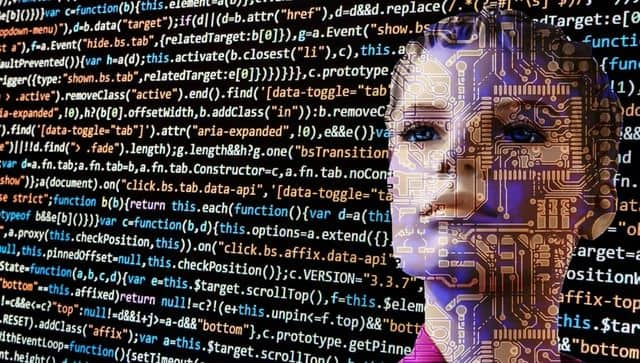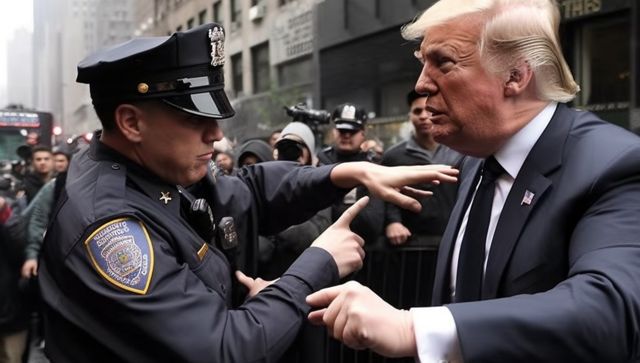Did you come across images of former United States president Donald Trump being arrested, or of Russian leader Vladimir Putin behind bars? If yes, then you have seen deepfakes. These fake pictures have gone viral at a time when news of Trump’s possible indictment and the International Criminal Court issuing an arrest warrant for Putin hit headlines worldwide. Trump’s pictures surrounded by New York City police officers were shared by Eliot Higgins, the founder of the open-source investigative outlet Bellingcat, on Twitter. His post has garnered 5.6 million views since being shared on 21 March. While the detailed images are not real and Higgins mentions this in his tweet, their virality has spurred concerns about the increasing role of artificial intelligence (AI) in spreading misinformation. What are deepfakes and why are they dangerous? Let’s take a closer look. What are deepfakes? The term deepfake is a portmanteau of “deep learning” and “fake”. It is a form of AI that is used to create distorted and fake images, videos and audio that are tried to pass off as real. A deep-learning system studies existing pictures or videos of the target person from different angles and then imitates that behaviour and speech patterns, as per a CNBC report.
Paul Barrett, adjunct professor of law at New York University, told CNBC in 2019 that “once a preliminary fake has been produced, a method known as GANs, or generative adversarial networks, makes it more believable. The GANs process seeks to detect flaws in the forgery, leading to improvements addressing the flaws.” After detection and some improvements, the deepfake video is completed, the professor added.
Recent uses of deepfakes As per The Guardian, deepfakes originated in 2017 when a Reddit user of the same name posted manipulated porn clips on the site. The videos contained swapped faces of famous female celebrities onto porn stars. Recently, a synthetic image of Putin kneeling and kissing the hand of Xi Jinping was widely shared on social media as the Chinese president met his Russian counterpart in Moscow this week, as per Associated Press (AP). Soon after Russia invaded Ukraine in February 2022, separate deepfake videos of Putin and his Ukrainian counterpart Volodymyr Zelenskyy spread online. While the deepfake video of Putin was declaring peace, Zelenskyy was shown asking Ukrainians to put down their weapons. The Ukrainian president had dismissed the video, calling it a “childish provocation”. Zelenskyy’s video was taken down by Meta and YouTube for violating misinformation rules. Ukrainian Center for Strategic Communications had warned Russia could use deepfakes to convince Ukrainians to surrender. Earlier, a fake video of former US president Barack Obama calling Trump a “complete dipshit” and Meta CEO Mark Zuckerberg’s deepfake boasting about “total control of billions of people’s stolen data” had created a storm on social media. In 2019, fraudsters used AI-based software to trick the chief of a UK subsidiary of a German energy firm to transfer around £200,000 into a Hungarian bank account. The caller had mimicked the voice of the CEO’s boss to get him to pay the money, reported The Wall Street Journal. ALSO READ: ChatGPT shakes up European Union’s plans to regulate artificial intelligence Why are deepfakes dangerous?
AI-generated images or deepfakes are capable of spreading misinformation on a large scale.
They can also be used to commit crimes, influence events such as elections, harm someone’s reputation as well as undermine trust in democratic institutions and media. AI image generator tools such as Midjourney, DALL-E and others have made it easier for people to create synthetic digital content and it may not always be used for the purpose of just entertainment. [caption id=“attachment_12347472” align=“alignnone” width=“640”] Deepfakes are being used to target women. Pixabay (Representational Image)[/caption] In 2019, AI firm Deeptrace found 15,000 deepfake videos online and the majority of them were pornographic. Danielle Citron, a professor of law at Boston University, told The Guardian at the time: “Deepfake technology is being weaponised against women.” “AI tools are already being used to put pictures of other people’s faces on the bodies of porn stars and put words in the mouths of politicians. GANs didn’t create this problem, but they’ll make it worse,” Martin Giles of MIT Technology Review wrote in an article in 2018. If the purpose of deepfake content is entertainment and even if the user clearly states so, it is not enough, says Shirin Anlen, media technologist at Witness, a New York-based human rights organisation that focuses on visual evidence. “Too often, the visuals are quickly reshared by others without that crucial context,” Allen said, as per AP. Deepfakes can also be deployed to create tensions between acrimonious nations or used by non-state actors to stir up chaos and conflict. Speaking to CNBC in 2019, John Villasenor, nonresident senior fellow of governance studies at the Center for Technology Innovation at Washington-based public policy organisation, warned about the dangers of deepfakes and how anyone with computer access can create such synthetic digital content. The technology “can be used to undermine the reputation of a political candidate by making the candidate appear to say or do things that never actually occurred.” “They are a powerful new tool for those who might want to (use) misinformation to influence an election,” Villasenor added. US Senator Mark R Warner, the chairman of the Senate Intelligence Committee, said: “Policymakers have been warning for years about the potential misuse of synthetic media to spread disinformation and more generally to sow confusion and discord,” reported The Washington Post. He said developers “should already be on notice: if your product directly enables harms that are reasonably foreseeable, you can be held potentially liable.” How to spot deepfake content? Experts say with deepfake technology becoming increasingly accessible and sophisticated, public awareness and education are required to combat such synthetic content intended to disseminate disinformation, reported AP. Poor-quality deepfakes are easy to spot – the hands may be weird or the person may have disheveled hair or the audio may not match the individual. “Presently, there are slight visual aspects that are off if you look closer, anything from the ears or eyes not matching to fuzzy borders of the face or too smooth skin to lighting and shadows,” Peter Singer, cybersecurity and defense-focused strategist and senior fellow at New America think tank, told CNBC. However, as technology becomes more sophisticated, deepfakes are becoming harder to differentiate from the real deal. Many tech companies are developing tools to identify deepfakes. Intel has a system called FakeCatcher that “identifies deepfakes with high levels of accuracy in real-time”. Last November, its researchers said the deepfake detection platform had 96 per cent accuracy. Meta has banned users from posting “highly manipulated” videos but allows such content if it is parody or satire. Twitter also bans “synthetic, manipulated, or out-of-context media” that may deceive or cause harm. What users can do on their part is be more aware while sharing content and pause and think if it is “too good to be true”. With inputs from agencies Read all the
Latest News
,
Trending News
,
Cricket News
,
Bollywood News
, India News
and
Entertainment News
here. Follow us on
Facebook
,
Twitter
and
Instagram
.
Deepfakes are being used to target women. Pixabay (Representational Image)[/caption] In 2019, AI firm Deeptrace found 15,000 deepfake videos online and the majority of them were pornographic. Danielle Citron, a professor of law at Boston University, told The Guardian at the time: “Deepfake technology is being weaponised against women.” “AI tools are already being used to put pictures of other people’s faces on the bodies of porn stars and put words in the mouths of politicians. GANs didn’t create this problem, but they’ll make it worse,” Martin Giles of MIT Technology Review wrote in an article in 2018. If the purpose of deepfake content is entertainment and even if the user clearly states so, it is not enough, says Shirin Anlen, media technologist at Witness, a New York-based human rights organisation that focuses on visual evidence. “Too often, the visuals are quickly reshared by others without that crucial context,” Allen said, as per AP. Deepfakes can also be deployed to create tensions between acrimonious nations or used by non-state actors to stir up chaos and conflict. Speaking to CNBC in 2019, John Villasenor, nonresident senior fellow of governance studies at the Center for Technology Innovation at Washington-based public policy organisation, warned about the dangers of deepfakes and how anyone with computer access can create such synthetic digital content. The technology “can be used to undermine the reputation of a political candidate by making the candidate appear to say or do things that never actually occurred.” “They are a powerful new tool for those who might want to (use) misinformation to influence an election,” Villasenor added. US Senator Mark R Warner, the chairman of the Senate Intelligence Committee, said: “Policymakers have been warning for years about the potential misuse of synthetic media to spread disinformation and more generally to sow confusion and discord,” reported The Washington Post. He said developers “should already be on notice: if your product directly enables harms that are reasonably foreseeable, you can be held potentially liable.” How to spot deepfake content? Experts say with deepfake technology becoming increasingly accessible and sophisticated, public awareness and education are required to combat such synthetic content intended to disseminate disinformation, reported AP. Poor-quality deepfakes are easy to spot – the hands may be weird or the person may have disheveled hair or the audio may not match the individual. “Presently, there are slight visual aspects that are off if you look closer, anything from the ears or eyes not matching to fuzzy borders of the face or too smooth skin to lighting and shadows,” Peter Singer, cybersecurity and defense-focused strategist and senior fellow at New America think tank, told CNBC. However, as technology becomes more sophisticated, deepfakes are becoming harder to differentiate from the real deal. Many tech companies are developing tools to identify deepfakes. Intel has a system called FakeCatcher that “identifies deepfakes with high levels of accuracy in real-time”. Last November, its researchers said the deepfake detection platform had 96 per cent accuracy. Meta has banned users from posting “highly manipulated” videos but allows such content if it is parody or satire. Twitter also bans “synthetic, manipulated, or out-of-context media” that may deceive or cause harm. What users can do on their part is be more aware while sharing content and pause and think if it is “too good to be true”. With inputs from agencies Read all the
Latest News
,
Trending News
,
Cricket News
,
Bollywood News
, India News
and
Entertainment News
here. Follow us on
Facebook
,
Twitter
and
Instagram
.
)